One of the most misunderstood aspects of distance running is the race itself. What most runners don’t realize is that racing is a skill. It’s a skill you can teach yourself and a skill you can practice, just like hitting a baseball or shooting a lay-up in basketball.
Most runners love numbers. We like to see the Garmin data with the exact pace, the heart rate, and the miles we accumulate. We get so fixated on the technical, physiological processes of training – lactate threshold, VO2max, heart rate, etc. – that we easily forget that racing is often a simple application of a specific skill; learning to push harder and run faster when you’re already tired.
Certainly, you’re going to have a hard time running a new personal best if you don’t train correctly, no matter how good at racing you are; but to really break through, you need to train to the specific demands of the race. You need to train to increase your effort as the race continues, adapt to increasing levels of fatigue, and to push through the discomfort. To illustrate this point, here is a graph of what a typical race effort feels like:
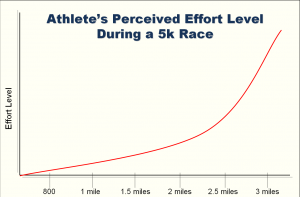
As humans, it is our natural instinct to survive. Our bodies are programmed to stop doing things that threaten our physical well-being. For example, when you put your hand on a hot stove, you’ll instinctively pull you hand back before it can be burned. Likewise, in a race where you’re running for a personal best, your body contemplates if continuing to run at your current speed will kill you. Most of the time, amidst the burning feeling in your legs and the short gasps for air, it is a logical question. Your body is always conspiring against you, making you want to slow down or stop. You need to teach yourself in your training how to overcome this natural inclination.
Too often, runners only experience this situation when they are in the actual race. They haven’t practiced this skill in their training. If your team was down one run in the 9th inning of the World Series, who would you want in the batter’s box? I hope you wouldn’t choose the chump off the bench who hadn’t swung a bat all season. Likewise, you don’t want to be the runner in your big goal race, who, when the chips are down, hasn’t practiced the specific skill to dig deep and push through the pain.
Luckily, with some innovative training ideas, you can teach your mind and your body these specific skills during your training runs. One way to practice this skill is to implement hammer intervals into your track sessions.
I first learned of hammer intervals from a former coach of mine, Scott Simmons. As Scott explains it, “one problem with traditional interval workouts that are run at a consistent pace is that the recovery between those intervals allows the athlete to recover to a state that is very unlike the corresponding point in a race”. To illustrate this concept, here is what the effort levels of a typical interval workout look like:
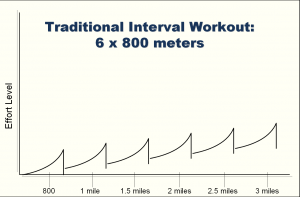
Compare this chart to the effort levels experienced during a race earlier in this article.
Notice how a typical interval workout does not teach you how to rise to that corresponding level of fatigue. To teach yourself this necessary skill, you must practice running “harder” when tired, just like you will have to do in a race. Let’s compare the typical interval workout to a hammer session. Here is a graph of effort levels during a hammer session:
You’ll notice that a hammer interval session looks more like the effort levels you’ll experience during a race. As you can see, the interval you “hammer” dramatically increases your level of fatigue, just at the point in the workout where you’re feeling the most tired. Because the rest interval stays the same, you do not completely recover as you would in a typical interval session, and you start the next hard repeat still tired from the hammer. This progression continues throughout the workout, providing you a much more race specific workout session and teaching your body how to push when it counts the most.
Hammer interval sessions should be implemented only after you have built a strong base of training and have completed a few strong workout sessions already. They are particularly effective for experienced runners who need a big change in stimulus to produce results. An example hammer workout for a 5k runner might look like: 8 x 800 meters at 3k to 5K race pace w/2mins rest, hammer (run as fast as you can) interval numbers 4 and number 7. Maintain the 2-minute rest after each hammer and do your best to get back onto 5k pace after each hammer.
By training to the specific mental and physical demands of the race, you set yourself up for a greater chance for success on race day. A special thanks to Scott Simmons for teaching me this truly unique and adaptive training idea and philosophy.

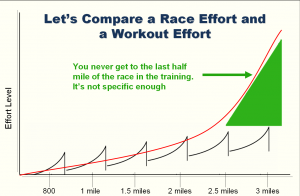
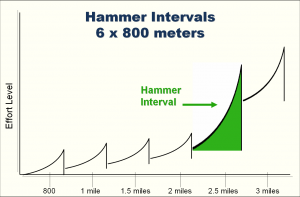
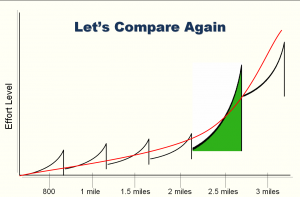




8 Responses
Awesome article, makes total sense. I tried it out this morning. Holy crap! And I thought regular 800’s were the devil. This will now be a regular workout for me, though. Thanks!
Sounds awesome! This is exactly what I need to change things up. I can’t wait to try it. Thx!
Very good idea, but man, that sounds really hard. 🙂 I would think that it would only be effective for runners who have the mental and physical strength to get back to 5K pace after such an exhausting repeat (and such a short rest).
Awesome article. Is it beneficial for 1/2 or marathon runners or mainly targets shorter distances.
Training to race, brilliant in its simplicity!
Now training for me to become a pro. racer thanks for this!
Good luck. Speed is all relative…